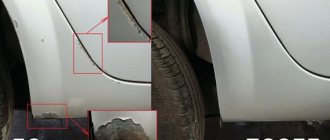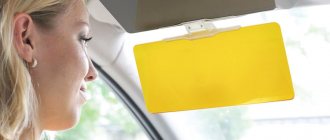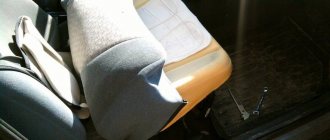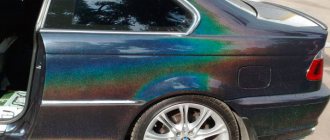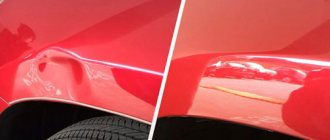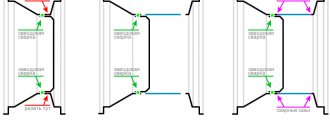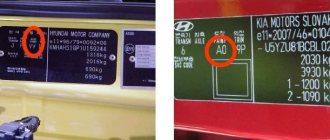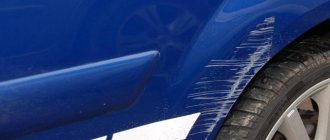Many car owners are interested in the question: why does the paint on a car peel off?
Although there may be many answers, this article contains the most important ones. Any automotive enamel will come off the car if it is not applied correctly. In addition, some car paint materials may not be compatible with each other.
Basically, the paint on a car peels for the following reasons:
- if the gloss has not been removed well enough before painting (there is nothing for the paint enamel to grab onto). Preparing a car for painting must be done efficiently;
- if the primer was alcohol-based (over time, alcohol-based primer turns into dust);
- if you painted plastic without a special primer (no enamel lasts more than 1-2 months on the surface of plastic, even if it was perfectly sanded);
- if the paint has passed its expiration date (expired enamel loses its properties);
- if the paint is diluted in incorrect proportions with the hardener (applies to two-component enamels);
- if the paint is applied against rust or dust (it is not designed for this);
- if the car was driven through caustic acids (resins and acids eat away the paintwork, and in some cases, if the car is treated with zinc, they react with it, and the paint may simply become deformed and chipped);
- if the car was painted in winter in a cold box (condensation contributes to poor adhesion of paints and varnishes);
- if the car was straightened using paintless technology (moisture, dust, dirt enter the paintwork through microcracks and over time the enamel becomes chipped).
As you already understand, the paint on a car can peel off very quickly, not only on a used car, but also on a new one. It all depends on how and where you drive. Therefore, do not rush to scold your master. Don't plunge into the ocean of negative emotions.
It’s better to stop and think about the above reasons for paint coming off your car. And remember, if the paintwork begins to peel off, painting the car yourself with high-quality paint can help.
How to paint a car correctly?
The technology for creating a body paint coating (LPC) involves layer-by-layer application of primer, base paint and varnish. Essentially, these are three different materials that need to be properly connected to each other. It is very easy to make mistakes, and their result will be a variety of paintwork defects.
An experienced car painter will almost always keep the paint firmly on the body. If something goes wrong during the process, a good master will definitely fix everything. As a result, the client will receive a high-quality painted car that will not peel or peel.
If you try to paint yourself, it is first recommended to familiarize yourself with the technology. You can use methodological literature or watch training videos. At the same time, it is important not to miss anything and study all the stages of painting. A good painter is not one who blindly follows technology, but one who understands the essence of each process.
How plastic is tested
Depending on the make of the car, all the plastic parts in its interior can be made from materials of different composition and quality.
Some of them need to be primed, others are not.
In our workshop we use the following methods to solve this problem:
- Cut a piece of plastic from an inconspicuous area.
- They set it on fire.
- They are lowered into the water.
- If the plastic burns and floats in water, then a primer is needed.
- If the material smokes and sinks in water, then there is no need to prime.
Important nuances of painting
Peeling paint always results in poor adhesion. In other words, there is simply nothing for the paint to cling to. It should be understood that paints and varnishes are not glue. They have a certain adhesion, but for smooth surfaces it is still insufficient.
Adhesion is influenced by two main factors - surface cleanliness and texture. Let's start with the first one. Before applying primer or paint, the base must be degreased. Novice painters do not quite understand why this is being done, because, in their opinion, there cannot be any grease on the parts being processed.
But there is fat on almost any surface. It is enough to touch the part with your fingers, and fingerprints will remain on it. They are formed by nothing more than sebum. Paint will not be able to adhere well to the base if there is even the thinnest layer of fat on it.
The source of fat is various resins, lubricants, cosmetic and medicinal creams, as well as insects. To remove grease from the work surface, you need to dissolve it and rinse it off, then remove the residue with a clean, dry rag.
You can degrease with a solvent or anti-silicone. Acetone solvents (646, 647) evaporate quickly, but can soften old paint and primer. Therefore, anti-silicone is most often used today to degrease painted parts. This product is not as aggressive as conventional organic solvents.
Putties should be degreased with 646 solvent, since it quickly disappears from its pores. Anti-silicone is contraindicated in this sense, since this product can linger for a long time in the structure of the putty.
Tips and recommendations for use
In order to protect against oils, dust or other influencing factors, a type such as electrical insulating enamel is used. Due to their brightness, protective and mechanical properties, alkyd paints can be used both outside and inside the car, not only on the entire body. In order to save paint and apply it evenly over the entire surface, a spray gun is used. Thanks to pneumatic spraying, it performs its functions perfectly.
The need for painting often arises during body repairs, after accidents. In order for the effect to be as positive as possible, you need to use the best auto enamels for your car. Resin solvents are used to soften paint.
For many enamels, varnishing and polishing are important to finish the job.
Calculation for car parts:
- rear wing – 300 ml;
- front steal - 200ml;
- front door – 200 ml;
- hood – 500 ml;
- trunk - 400 ml;
- thresholds – 300 ml.
Color Chart
Car enamels have basically two main directions - metallic and non-metallic. Metallics have a pearlescent tint, non-metallics do not. The car paint chart is represented by hundreds of colors, ranging from bright to black shades. Paint is sold in automotive stores in almost any color.
Motorists and professionals use various methods of applying paint to cars.
- Using an aerosol. This method is best for home dyeing. Alkyd and acrylic are used;
- With special equipment. This method is used to quickly and evenly apply enamel;
- Without equipment, since there are cases when it is not practical to use it;
- Using a pencil for spot application;
Why does varnish come off from metal body parts?
Painting technology is a precise sequence of actions. If you violate even one stage, the paint can quickly peel off or take on an undesirable appearance.
Inexperienced craftsmen (newbies) violate technology in the following ways:
- They forget to matte (take off the gloss).
- They degrease poorly or don’t do it at all.
- Does not remove paint dust.
- Let the paint dry before applying varnish.
- The proportions are violated when diluting the enamel.
The nuances described above lead to the peeling of any automobile enamel from the car body. There is only one way to avoid poor-quality car painting - entrust the car to a specialized car service.
A good painter can be found through the recommendation of a friend who has already repaired his car and can show clear results. A great car painting specialist has a business-like approach. The master immediately stipulates the cost of repairs, time and materials that will be used in the work.
The varnish is coming off the plastic.
Varnish can not only fly off metal parts, but also plastic ones (more often with the latter). The reasons for this phenomenon are the following:
- The new bumper does not lose its gloss, so there is nothing for the primer and paint to catch on.
- The bumper, after matting and degreasing, is not opened with plastic primer, but paint is applied immediately.
Garage workers, in order to save time and money, often paint bumpers without a primer for plastic. The trick goes away, as the paint does not start to fly off immediately, but after about 1-2 months. During this time, resellers even manage to sell the car quickly.
There are reasons that do not depend on the master:
- Expired varnish. Expired enamel begins to deteriorate at the molecular level and loses its properties.
- Frozen varnish. Improper storage in severe frost also leads to loss of properties. Such enamels can be found on the automobile market in severe frost.
Alkyd enamel
This type of car enamel is made on a base of alkyd resins. This car paint is convenient because you don’t need to create special conditions when working with it.
With full painting, it is not used very often - after applying it, you will also need to coat the car with varnish and polish it. Alkyd PF 115 car enamel is most often used for local painting work.
1K enamel Kudo automotive, Alkyd
Experts note the following advantages of this type:
- quick drying;
- reasonable prices;
- high level of protection;
- ease of use.
The main disadvantage of alkyd materials is that they dry as quickly as possible, as a result of which they do not dry very evenly. Therefore, when painting, it is recommended to use a spray gun or an aerosol version, in which the substance is sprayed from a can. This gives a small layer thickness, which has a positive effect on the quality of the coating.
Alkyd auto enamels "Bulmat"
How to correct the situation if the varnish starts to come off from the car?
Violation of the car body painting technology becomes noticeable after a while, when the consequences begin to appear. For example, the varnish will peel off. It is useless to prove anything to the painter after 2-3 months, especially if he does not know how to paint differently (but you can try to reimburse part of the funds).
First of all, you need to find a good painter, preferably a qualified service. It is possible from a garage, but strictly on the excellent recommendation of friends and acquaintances. To improve the situation, there is only one way out - to clean off the old varnish down to the paint and repaint the car with high quality.
And one more tip! No matter how professional the painter is, high-quality painting can only be done in a special painting chamber, because it sets not only a certain temperature, but also other climatic parameters. If the auto repair shop does not have such equipment, it is better not to go there.
And the last thing! Even a good spray booth should have all types of filters. If they are clogged or missing, the varnish or paint will mix with external dust, and there is no need to talk about quality.
Why is this happening
Despite the fact that many do not distinguish between the two different types of bloating, you need to immediately separate them for yourself, because the causes of occurrence in both types are completely different. So, having found bubbles or film, you must find out what exactly happened to the top layer of your car:
- The factory paint began to peel off from the surface like a film; it could literally be peeled off in layers. This kind of delamination can be observed on the car body, and it is the first type
- The paint swells with bubbles after you have painted the car in the interior, and the swelling occurs in completely unpredictable places. This is the second type.
In practice, outwardly, both types are easily confused and impossible to distinguish immediately, but in order to understand the causes of problems with the painted surface in the form of swelling and delamination, you need to find out which of the two types of misfortune has visited your car.
If the factory paint layer is damaged
If the factory paint layer is suffering, then you have few options. The problem is that the paint layer separates from the metal surface. This means that the hard surface for some reason has changed its properties. Metal corrosion occurs for two main reasons. This:
- The top layer of paintwork was damaged. Despite the fact that many people do not think about the other properties of paint other than the cosmetic effect, in fact this layer protects the metal from external destructive influences. This means that the first paint damage (scratches or something like that) will lead to a chain of metal corrosion - an increased area of damaged paintwork - an increased area of damaged hard layer.
- The metal began to collapse without external influences from the inside on its own.
The first case is the most common. Air, moisture, dust - all this literally kills your car. The natural processes that occur with metal without a protective layer - oxidation, corrosion, rust formation - should be known to every student after a chemistry course. The outbreak gradually grows, covering a larger and larger area. Even small, almost imperceptible rust, which you cannot see without careful examination, will already become an obstacle to the normal adhesion of paint and metal. Any paint surface that comes into contact with a surface that is susceptible to corrosion will not be able to obtain proper adhesion to the surface. As a result, the paint will peel off, the exposed surface area will increase and become damaged due to contact with the external environment. Such a vicious circle.
Such local swelling initially has a small area and is completely invisible if it is not located in the most visible places. As the affected area grows, it will become completely impossible to ignore the swelling. It's a completely different matter when destruction begins from within. Then corrosion is the cause, and swelling is the consequence. First, metal destruction occurs on a layer invisible from the outside; this process occurs quietly and imperceptibly. And only when the damage is already significant enough will the paint begin to swell, signaling a missed problem.
Metal paints for exterior use - features
Metal is a specific material that has a slippery surface with minimal roughness. This causes low adhesive properties of such surfaces. That is, it is difficult for paint to adhere to such material.
In addition, when applying paints and varnishes, it is necessary to take into account that the metal needs to be protected from the negative effects of water. Therefore, the compositions used must be water-repellent. Otherwise, the metal surface will quickly rust and you will often have to renew the paint layer.
These points should be taken into account when choosing coatings for outdoor work.
When applying paints and varnishes, it is necessary to take into account that the metal needs to be protected from the negative effects of water.
Why paint metal
Metal surfaces must be painted to achieve the following effects:
- Increasing the strength of the structure, eliminating negative factors leading to its destruction;
- Resistance to high temperatures. Some types of paints can withstand heat of 1000°C;
- Reducing the rate of rust formation. If a layer of paint is applied to the cleaned rusty metal, the structure will remain in good, unchanged condition for some time. Without such a coating, it quickly deteriorates.
To summarize the parameters for which iron paint is used, it is worth noting the increase in wear resistance of a metal product coated with paintwork materials.
Some types of paints can withstand heat of 1000°C.
What are the requirements for paints?
When considering the basic requirements that metal paint for exterior metal work must meet, it is important to note the following points:
- Application area. It is necessary to choose only those types that can be used outside. This is due to the fact that the resistance to negative factors of such a coating will be much higher in comparison with finishing materials used for interior work;
- Paint toxicity. It is important to know the level of harmful effects of a particular paint material on human health. Only in this case can appropriate protective measures be taken when performing work;
- Thermal stability is an essential factor that must be present in metal paints. The correct layer will help protect against heat exposure in possible fire situations;
- Inert to chemical reagents. Any paint and varnish material, to one degree or another, resists the effects of aggressive chemicals. But when choosing paint for a specific case, you need to make sure how high this indicator should be.
It is necessary to choose only those types that can be used outside.
What to do if the paint on your car is blistered
Despite the fact that at the stage at which the car owner notices the problem, its manifestations will be the same - just swollen paint - the methods of dealing with different types will differ. The first option, when the destruction began with a layer of paint, is easier to eliminate. You don’t even have to repaint the entire car, but rather restore the damaged areas yourself. If you did not delay with this problem and did not allow severe damage, then this will be enough. The second option will require you to repair it from the inside. Often you have to use welding. In cases where the damage went unnoticed for a long time, the body part may even need to be replaced.
Types of paints
Our salon specialists usually use the following materials:
- Acrylic cream. It is used for dyeing leather. It gives a rich color and can retain the original shade for up to 10 years. It is abrasion resistant and is used for retouching.
- Acrylic paint. It has a light composition and dries quickly.
- Aerosol. This is the most popular form of painting.
If you use it, then nearby objects must be covered.
- Two-component varnish. It is applied to the parts of the front panel of the car, as it is able to protect the surface from mechanical influences.
